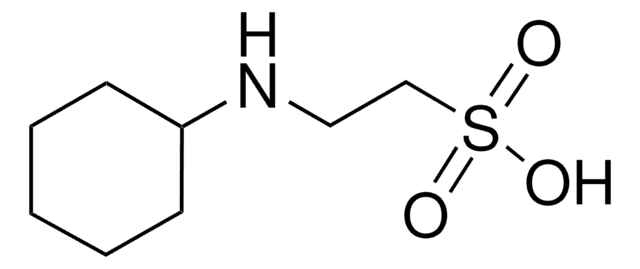P2949
PIPES sodium salt
≥99% (titration)
Sinónimos:
Na-PIPES, Piperazine-1,4-diethanesulfonate sodium salt, 1,4-Piperazinediethanesulfonic acid sodium salt, Piperazine-N,N′-bis(2-ethanesulfonic acid) sodium salt
About This Item
Productos recomendados
Nivel de calidad
Análisis
≥99% (titration)
formulario
crystalline powder
pH
4.5-4.7
intervalo de pH útil
6.1-7.5
pKa (25 °C)
6.8
solubilidad
0.1 M NaOH: 250 mg/mL, clear, colorless
aplicaciones
diagnostic assay manufacturing
temp. de almacenamiento
room temp
cadena SMILES
[Na+].OS(=O)(=O)CCN1CCN(CC1)CCS([O-])(=O)=O
InChI
1S/C8H18N2O6S2.Na/c11-17(12,13)7-5-9-1-2-10(4-3-9)6-8-18(14,15)16;/h1-8H2,(H,11,12,13)(H,14,15,16);/q;+1/p-1
Clave InChI
OGGAIRCLBMGXCZ-UHFFFAOYSA-M
¿Está buscando productos similares? Visita Guía de comparación de productos
Descripción general
Aplicación
- to prepare BRB80 buffer for imaging dynamic microtubules and single kinesin molecules through fluorescence microscopy
- as a component of PEM fixation solution
- to reconstitute red blood cells (RBCs) to study the effect of pH on 5-coordinate alpha-nitrosyl-hemoglobin (HbNO) stability
Características y beneficios
- Non-toxic
- Easy to use
- Thermally stable
- Easy to handle and store
Código de clase de almacenamiento
11 - Combustible Solids
Clase de riesgo para el agua (WGK)
WGK 3
Punto de inflamabilidad (°F)
Not applicable
Punto de inflamabilidad (°C)
Not applicable
Certificados de análisis (COA)
Busque Certificados de análisis (COA) introduciendo el número de lote del producto. Los números de lote se encuentran en la etiqueta del producto después de las palabras «Lot» o «Batch»
¿Ya tiene este producto?
Encuentre la documentación para los productos que ha comprado recientemente en la Biblioteca de documentos.
Los clientes también vieron
Nuestro equipo de científicos tiene experiencia en todas las áreas de investigación: Ciencias de la vida, Ciencia de los materiales, Síntesis química, Cromatografía, Analítica y muchas otras.
Póngase en contacto con el Servicio técnico






